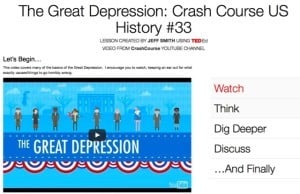
“Breadline” by Margaret Bourke-White, 1937
The world continues to be an ever-evolving place, and, as with all things, educational strategies must adapt in parallel. Today, the most significant change is occurring in the field of technology, and incorporating its use into the classroom is essential to aligning with the evolving needs of students. Perhaps the most obvious use of this new resource is for delivery of content, and teachers across the world are finding it beneficial to “flip” their classroom, having students watch videos the night before class. This frees up in-class time for interactive activities and project-based learning.
 Here’s a link is to a Ted-Ed lesson on the causes of the Great Depression. Students watch the video, answer a few questions, and are presented with additional materials to explore and space to converse with each other. The video raises several points of debate and is largely inconclusive as to specific causes, setting the stage for the activity the following day. In-class, students will be presented with many strips of paper, each with a different factor contributing to the Great Depression. In groups, they will sort the strips by level of impact, discussing their rationale as they go. Once completed, results will be collected and analyzed to produce a class-wide list generated from average list position for each cause. A whole group discussion and debate on the list will conclude the session.
Here’s a link is to a Ted-Ed lesson on the causes of the Great Depression. Students watch the video, answer a few questions, and are presented with additional materials to explore and space to converse with each other. The video raises several points of debate and is largely inconclusive as to specific causes, setting the stage for the activity the following day. In-class, students will be presented with many strips of paper, each with a different factor contributing to the Great Depression. In groups, they will sort the strips by level of impact, discussing their rationale as they go. Once completed, results will be collected and analyzed to produce a class-wide list generated from average list position for each cause. A whole group discussion and debate on the list will conclude the session.
In my professional career, I fully plan to utilize the flipped lesson model quite often. I am a proponent of project-based learning, and freeing up time for in-class collaboration is at the heart of this approach. In my own career as a student, I found interactive tasks that generated a product offered opportunities to feel genuinely proud of my schoolwork, something strikingly absent from the traditional endless chain of worksheets. Flipping content delivery to the night before allows for this type of meaningful exploration of the material. Kids can learn by doing rather than just listening.
The traditional top-down-lecture model of education has been made essentially irrelevant by technology. It is simply not practical to ask students to sit and listen to a speech when they can find the same material online with a quick internet search. Online materials can be paused, re-watched, and used as reference, creating a useful tool where once only a fleeting lecture was available. The new task of teachers is to teach students how to use these new tools effectively, and how to assess the sources of information they find. These are distinct skills that must be taught directly and absorbed through repetition. It’s a good thing there’ll be so much time in class to work on them.
Image credit: link
